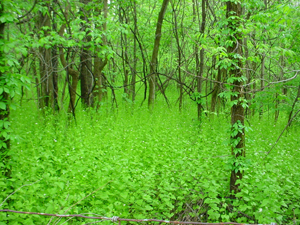
Closeup of garlic mustard flower © Lynn Jenkins
Garlic mustard may sound tasty, but it’s poison for native plants and a nightmare for gardeners and naturalists.
Shortly after the Civil War, European immigrants brought garlic mustard (Alliaria petiolata) to the United States to use for food and medicinal purposes.
It escaped from their backyards, spread throughout the Eastern United States, taking root in natural areas, parks, along roadsides, and yes, in our backyards.
Garlic mustard is a biennial. The first year, a seed germinates and forms a cluster of low-growing leaves, called a rosette. The second year, it blooms.
This is the time of the year to be alert for this weed. Garlic mustard has heart-shaped, scalloped leaves, stands two to three feet tall and sports a crown of white, star like flowers. And just so we don’t confuse it with one of several, white flowering native plants, garlic mustard smells garlicky.
Each plant produces thousands of seeds, which can spread several feet and live in the soil for at least five years.
Garlic mustard threatens native species, such as spring beauties, wild ginger and trillium, because they bloom at the same time and prefer similar habitats. Garlic mustard overwhelms native plants, depriving them of nutrients, water and light. This matters because wildlife relies on the early blooming species’ seeds, pollen, roots and nectar for food.
The best way to get rid of this invasive plant in small areas is to keep it from going to seed by hand pulling. Be sure to pull the entire plant because it will grow from any remaining root. Remove blooming plants from the site so they don’t reseed the area.

Unsavory — Garlic mustard colonizes woodland in rural Zionsville, Indiana © Lynn Jenkins
If there’s a large infestation, cut the plants down as close to the ground as possible, preferable before flowers form. Rake out and dispose the plants if they are flowering or have seed pods.
Because garlic mustard blooms simultaneously with many desirable plants, herbicides may be difficult to use, so always read and follow label directions. For long-standing, heavy colonies or small patches, it will take several years of vigilance to get this weed under control.
For more information, please visit the Plant Conservation Alliance, Alien Plant Working Group.
[…] de tuin toen we er kwamen wonen, en dat heeft zich … Mail (will not be published) (required) …Concerted effort needed to control garlic mustard | Hoosier …Hoosier Gardener – Jo Ellen Meyers Sharp, Garlic mustard may sound tasty, but it's poison for native […]